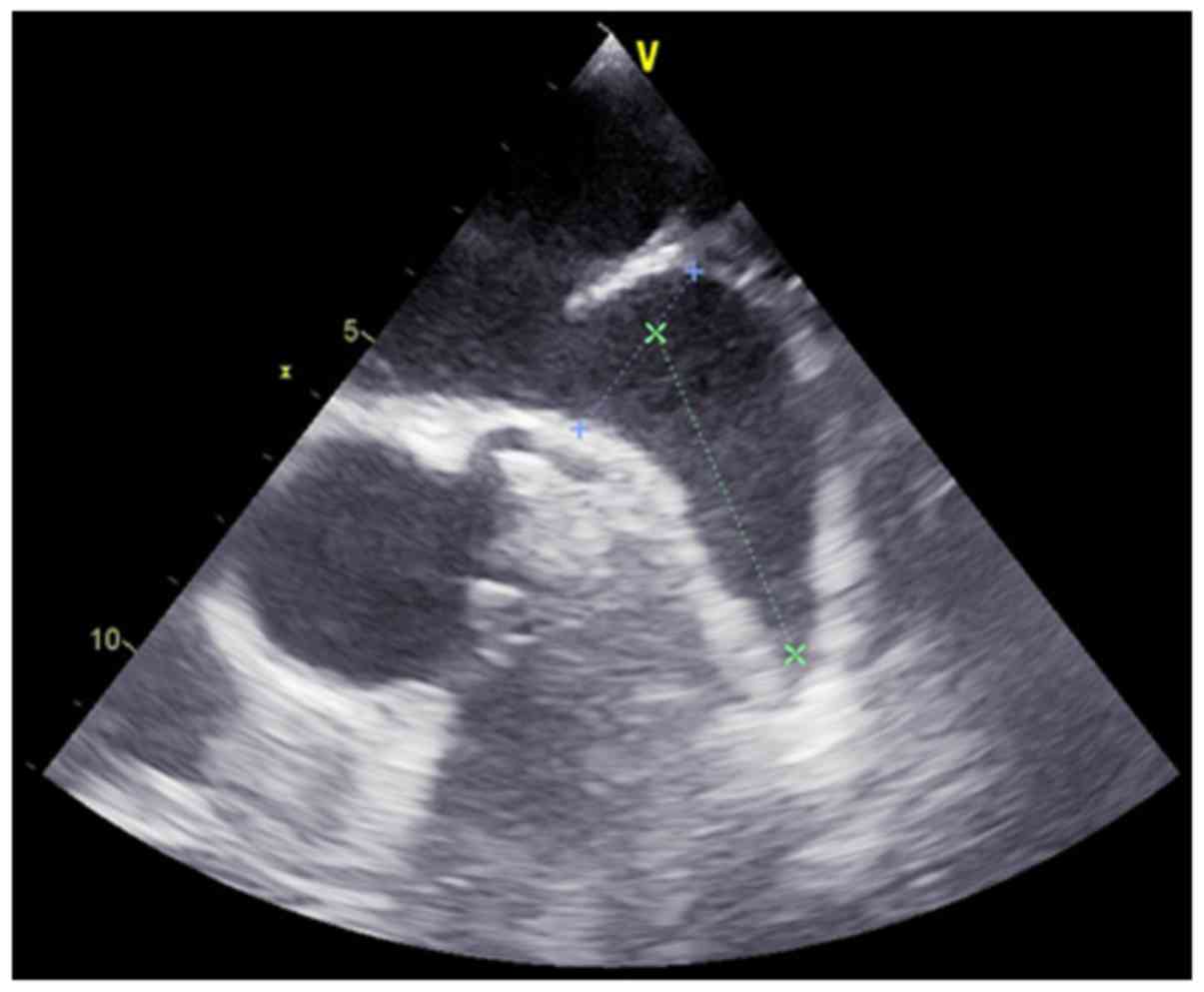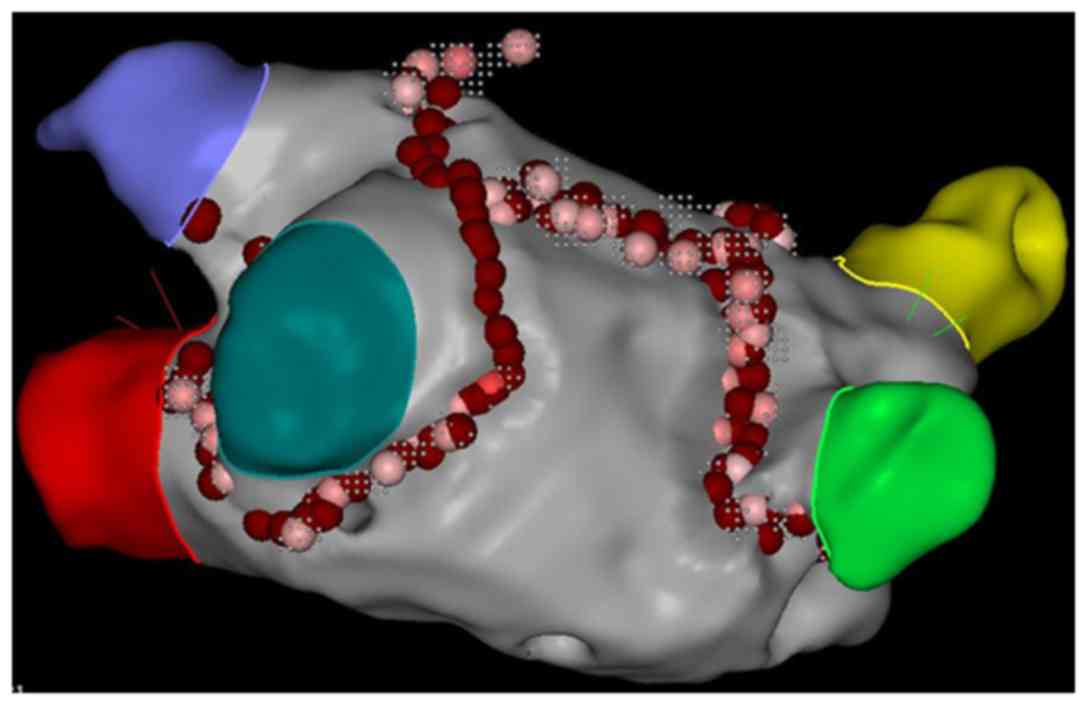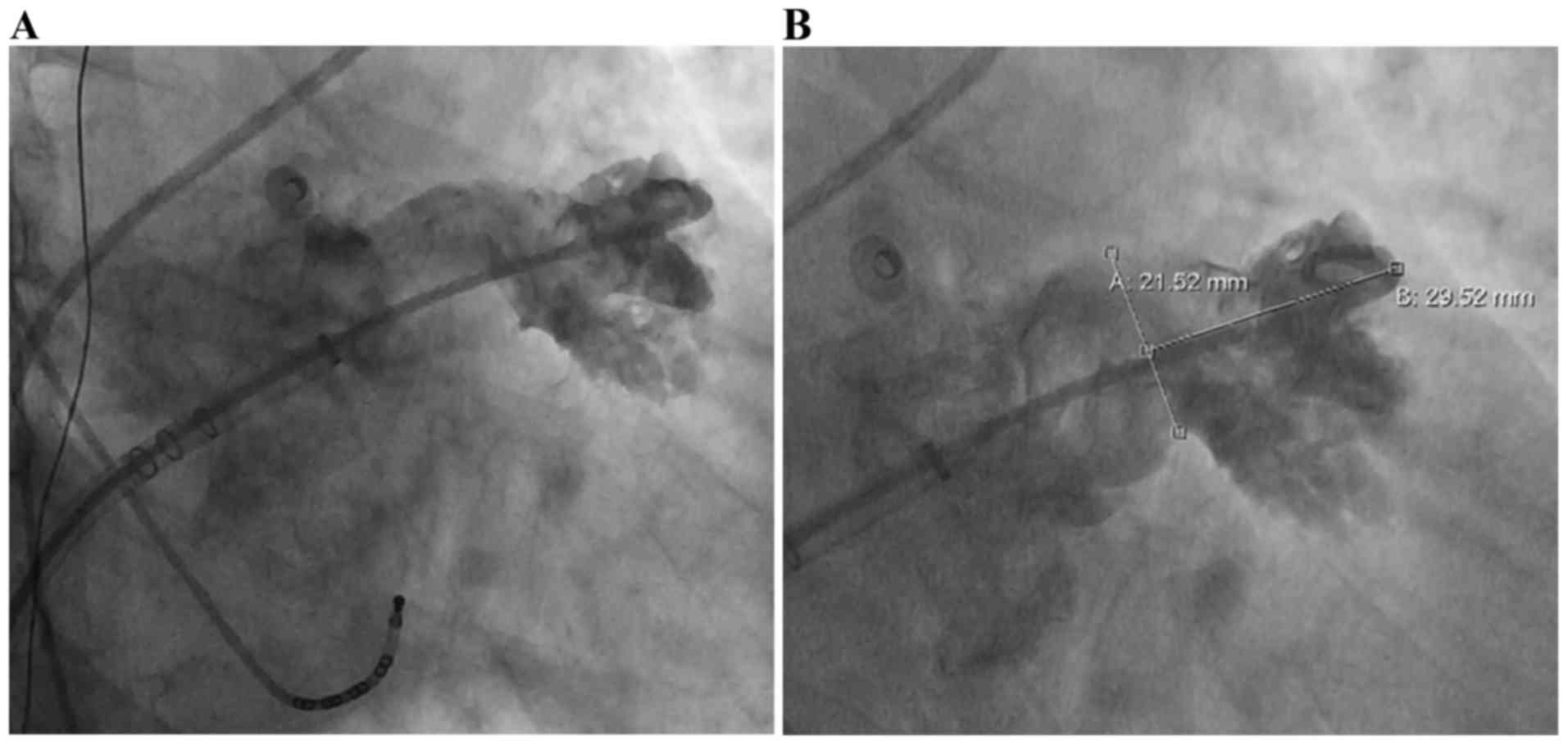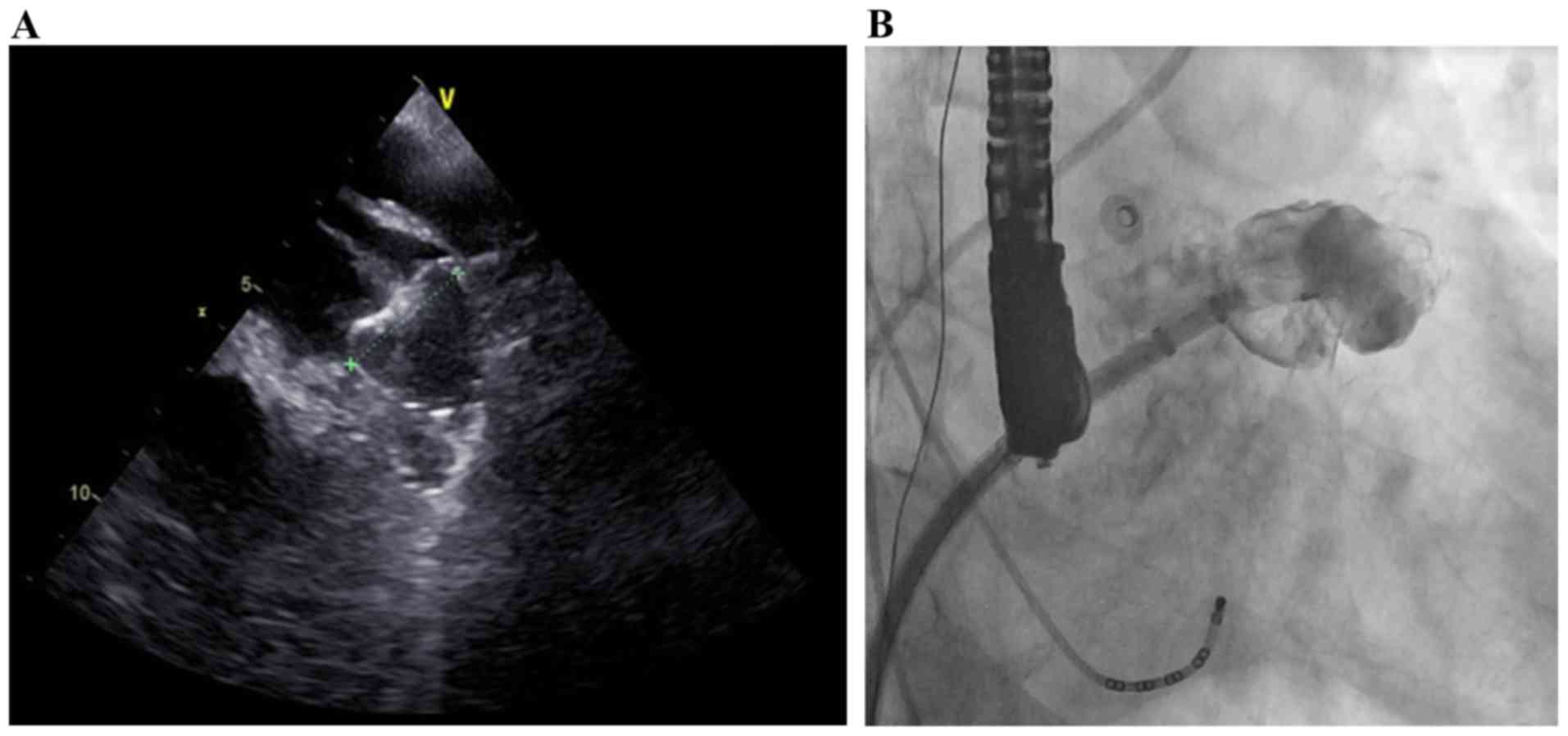|
1
|
Camm AJ, Kirchhof P, Lip GY, Schotten U,
Savelieva I, Ernst S, Van Gelder IC, Al-Attar N, Hindricks G,
Prendergast B, et al: Guidelines for the management of atrial
fibrillation: The Task Force for the Management of Atrial
Fibrillation of the European Society of Cardiology (ESC). Europace.
12:1360–1420. 2010. View Article : Google Scholar : PubMed/NCBI
|
|
2
|
Go AS, Hylek EM, Phillips KA, Chang Y,
Henault LE, Selby JV and Singer DE: Prevalence of diagnosed atrial
fibrillation in adults: National implications for rhythm management
and stroke prevention: The AnTicoagulation and risk factors in
atrial fibrillation (ATRIA) study. JAMA. 285:2370–2375. 2001.
View Article : Google Scholar : PubMed/NCBI
|
|
3
|
Stewart S, Hart CL, Hole DJ and McMurray
JJ: Population prevalence, incidence, and predictors of atrial
fibrillation in the Renfrew/Paisley study. Heart. 86:516–521. 2001.
View Article : Google Scholar : PubMed/NCBI
|
|
4
|
Lloyd-Jones D, Adams R, Carnethon M, De
Simone G, Ferguson TB, Flegal K, Ford E, Furie K, Go A, Greenlund
K, et al: Heart disease and stroke statistics - 2009 update: A
report from the American Heart Association Statistics Committee and
Stroke Statistics Subcommittee. Circulation. 119:480–486. 2009.
View Article : Google Scholar : PubMed/NCBI
|
|
5
|
Lloyd-Jones DM, Wang TJ, Leip EP, Larson
MG, Levy D, Vasan RS, D'Agostino RB, Massaro JM, Beiser A, Wolf PA
and Benjamin EJ: Lifetime risk for development of atrial
fibrillation: The Framingham Heart Study. Circulation.
110:1042–1046. 2004. View Article : Google Scholar : PubMed/NCBI
|
|
6
|
Goldman ME, Pearce LA, Hart RG,
Zabalgoitia M, Asinger RW, Safford R and Halperin JL:
Pathophysiologic correlates of thromboembolism in nonvalvular
atrial fibrillation: I. Reduced flow velocity in the left atrial
appendage (The stroke prevention in atrial fibrillation (SPAF-III)
study). J Am Soc Echocardiogr. 12:1080–1087. 1999. View Article : Google Scholar : PubMed/NCBI
|
|
7
|
Kirchhof P, Benussi S, Kotecha D, Ahlsson
A, Atar D, Casadei B, Castellá M, Diener HC, Heidbuchel H, Hendriks
J, et al: 2016 ESC guidelines for the management of atrial
fibrillation developed in collaboration with EACTS. Rev Esp Cardiol
(Engl Ed). 70:502017.(In English, Spanish). PubMed/NCBI
|
|
8
|
Baker WL, Cios DA, Sander SD and Coleman
CI: Meta-analysis to assess the quality of warfarin control in
atrial fibrillation patients in the United States. J Manag Care
Pharm. 15:244–252. 2009.PubMed/NCBI
|
|
9
|
Hylek EM, Evans-Molina C, Shea C, Henault
LE and Regan S: Major hemorrhage and tolerability of warfarin in
the first year of therapy among elderly patients with atrial
fibrillation. Circulation. 115:2689–2696. 2007. View Article : Google Scholar : PubMed/NCBI
|
|
10
|
Lip GY, Andreotti F, Fauchier L, Huber K,
Hylek E, Knight E, Lane DA, Levi M, Marin F, Palareti G, et al:
Bleeding risk assessment and management in atrial fibrillation
patients: A position document from the European Heart Rhythm
Association, endorsed by the European Society of Cardiology Working
Group on Thrombosis. Europace. 13:723–746. 2011. View Article : Google Scholar : PubMed/NCBI
|
|
11
|
Holmes DR, Reddy VY, Turi ZG, Doshi SK,
Sievert H, Buchbinder M, Mullin CM and Sick P: PROTECT AF
Investigators: Percutaneous closure of the left atrial appendage
versus warfarin therapy for prevention of stroke in patients with
atrial fibrillation: A randomised non-inferiority trial. Lancet.
374:534–542. 2009. View Article : Google Scholar : PubMed/NCBI
|
|
12
|
Reddy VY, Holmes D, Doshi SK, Neuzil P and
Kar S: Safety of percutaneous left atrial appendage closure:
Results from the Watchman left atrial appendage system for embolic
protection in patients with AF (PROTECT AF) clinical trial and the
continued access registry. Circulation. 123:417–424. 2011.
View Article : Google Scholar : PubMed/NCBI
|
|
13
|
Reddy VY, Doshi SK, Sievert H, Buchbinder
M, Neuzil P, Huber K, Halperin JL and Holmes D: PROTECT
AFInvestigators: Percutaneous left atrial appendage closure for
stroke prophylaxis in patients with atrial fibrillation: 2.3-Year
follow-up of the PROTECT AF (Watchman left atrial appendage system
for embolic protection in patients with atrial fibrillation) trial.
Circulation. 127:720–729. 2013. View Article : Google Scholar : PubMed/NCBI
|
|
14
|
Gage BF, Waterman AD, Shannon W, Boechler
M, Rich MW and Radford MJ: Validation of clinical classification
schemes for predicting stroke: Results from the National Registry
of Atrial Fibrillation. JAMA. 285:2864–2870. 2001. View Article : Google Scholar : PubMed/NCBI
|
|
15
|
Lip GY, Nieuwlaat R, Pisters R, Lane DA
and Crijns HJ: Refining clinical risk stratification for predicting
stroke and thromboembolism in atrial fibrillation using a novel
risk factor-based approach: The euro heart survey on atrial
fibrillation. Chest. 137:263–272. 2010. View Article : Google Scholar : PubMed/NCBI
|
|
16
|
Lip GY, Frison L, Halperin JL and Lane DA:
Comparative validation of a novel risk score for predicting
bleeding risk in anticoagulated patients with atrial fibrillation:
The HAS-BLED (hypertension, abnormal renal/liver function, stroke,
bleeding history or predisposition, labile INR, elderly,
drugs/alcohol concomitantly) score. J Am Coll Cardiol. 57:173–180.
2011. View Article : Google Scholar : PubMed/NCBI
|
|
17
|
Fountain RB, Holmes DR, Chandrasekaran K,
Packer D, Asirvatham S, Van Tassel R and Turi Z: The PROTECT AF
(WATCHMAN Left Atrial Appendage System for Embolic PROTECTion in
patients with atrial fibrillation) trial. Am Heart J. 151:956–961.
2006. View Article : Google Scholar : PubMed/NCBI
|
|
18
|
Belgaid DR, Khan Z, Zaidi M and Hobbs A:
Prospective randomized evaluation of the watchman left atrial
appendage closure device in patients with atrial fibrillation
versus long-term warfarin therapy: The PREVAIL trial. Int J
Cardiol. 219:177–179. 2016. View Article : Google Scholar : PubMed/NCBI
|
|
19
|
Alli O, Doshi S, Kar S, Reddy V, Sievert
H, Mullin C, Swarup V, Whisenant B and Holmes D Jr: Quality of life
assessment in the randomized PROTECT AF (percutaneous closure of
the left atrial appendage versus warfarin therapy for prevention of
stroke in patients with atrial fibrillation) trial of patients at
risk for stroke with nonvalvular atrial fibrillation. J Am Coll
Cardiol. 61:1790–1798. 2013. View Article : Google Scholar : PubMed/NCBI
|
|
20
|
Arbelo E, Brugada J, Hindricks G, Maggioni
AP, Tavazzi L, Vardas P, Laroche C, Anselme F, Inama G, Jais P, et
al: The atrial fibrillation ablation pilot study: A European Survey
on Methodology and results of catheter ablation for atrial
fibrillation conducted by the European Heart Rhythm Association.
Eur Heart J. 35:1466–1478. 2014. View Article : Google Scholar : PubMed/NCBI
|
|
21
|
Calkins H, Kuck KH, Cappato R, Brugada J,
Camm AJ, Chen SA, Crijns HJ, Damiano RJ Jr, Davies DW, DiMarco J,
et al: 2012 HRS/EHRA/ECAS Expert Consensus Statement on Catheter
and Surgical Ablation of Atrial Fibrillation: Recommendations for
patient selection, procedural techniques, patient management and
follow-up, definitions, endpoints, and research trial design.
Europace. 14:528–606. 2012. View Article : Google Scholar : PubMed/NCBI
|
|
22
|
Mont L, Bisbal F, Hernández-Madrid A,
Pérez-Castellano N, Viñolas X, Arenal A, Arribas F,
Fernández-Lozano I, Bodegas A, Cobos A, et al: Catheter ablation
vs. antiarrhythmic drug treatment of persistent atrial
fibrillation: A multicentre, randomized, controlled trial (SARA
study). Eur Heart J. 35:501–507. 2014. View Article : Google Scholar : PubMed/NCBI
|
|
23
|
Walfridsson H, Walfridsson U, Nielsen JC,
Johannessen A, Raatikainen P, Janzon M, Levin LA, Aronsson M,
Hindricks G, Kongstad O, et al: Radiofrequency ablation as initial
therapy in paroxysmal atrial fibrillation: Results on
health-related quality of life and symptom burden. The MANTRA-PAF
trial. Europace. 17:215–221. 2015. View Article : Google Scholar : PubMed/NCBI
|
|
24
|
Kuck KH, Hoffmann BA, Ernst S, Wegscheider
K, Treszl A, Metzner A, Eckardt L, Lewalter T, Breithardt G and
Willems S: Gap-AF-AFNET 1 Investigators*: Impact of complete versus
incomplete circumferential lines around the pulmonary veins during
catheter ablation of paroxysmal atrial fibrillation: Results from
the gap-atrial fibrillation-German atrial fibrillation competence
network 1 trial. Circ Arrhythm Electrophysiol. 9:e0033372016.
View Article : Google Scholar : PubMed/NCBI
|
|
25
|
McLellan AJ, Ling LH, Azzopardi S, Lee GA,
Lee G, Kumar S, Wong MC, Walters TE, Lee JM, Looi KL, et al: A
minimal or maximal ablation strategy to achieve pulmonary vein
isolation for paroxysmal atrial fibrillation: A prospective
multi-centre randomized controlled trial (the Minimax study). Eur
Heart J. 36:1812–1821. 2015. View Article : Google Scholar : PubMed/NCBI
|
|
26
|
Verma A, Sanders P, Macle L, Deisenhofer
I, Morillo CA, Chen J, Jiang CY, Ernst S and Mantovan R: Substrate
and trigger ablation for reduction of atrial fibrillation
trial-part II (STAR AF II): Design and rationale. Am Heart J.
164:1–6.e6. 2012. View Article : Google Scholar : PubMed/NCBI
|
|
27
|
Luik A, Radzewitz A, Kieser M, Walter M,
Bramlage P, Hörmann P, Schmidt K, Horn N, Brinkmeier-Theofanopoulou
M, Kunzmann K, et al: Cryoballoon versus open irrigated
radiofrequency ablation in patients with paroxysmal atrial
fibrillation: The prospective, randomized, controlled,
noninferiority freezeaf study. Circulation. 132:1311–1319. 2015.
View Article : Google Scholar : PubMed/NCBI
|
|
28
|
Schmidt M, Dorwarth U, Andresen D,
Brachmann J, Kuck KH, Kuniss M, Lewalter T, Spitzer S, Willems S,
Senges J, et al: Cryoballoon versus RF ablation in paroxysmal
atrial fibrillation: Results from the German Ablation Registry. J
Cardiovasc Electrophysiol. 25:1–7. 2014. View Article : Google Scholar : PubMed/NCBI
|
|
29
|
Reynolds MR, Gunnarsson CL, Hunter TD,
Ladapo JA, March JL, Zhang M and Hao SC: Health outcomes with
catheter ablation or antiarrhythmic drug therapy in atrial
fibrillation: Results of a propensity-matched analysis. Circ
Cardiovasc Qual Outcomes. 5:171–181. 2012. View Article : Google Scholar : PubMed/NCBI
|
|
30
|
Phillips KP, Walker DT and Humphries JA:
Combined catheter ablation for atrial fibrillation and
Watchman® left atrial appendage occlusion procedures:
Five-year experience. J Arrhythm. 32:119–126. 2016. View Article : Google Scholar : PubMed/NCBI
|
|
31
|
Walker DT, Humphries JA and Phillips KP:
Combined catheter ablation for atrial fibrillation and
watchman® left atrial appendage occlusion procedures: A
single centre experience. J Atr Fibrillation. 5:6872012.PubMed/NCBI
|
|
32
|
Bolao IG, Calvo N, Macias A, Barba J,
Salterain N, Ramos P, Ballesteros G and Neglia R: Ablation of
atrial fibrillation in combination with left atrial appendage
occlusion in a single procedure. Rationale and technique. J Atr
Fibrillation. 8:13462016.PubMed/NCBI
|
|
33
|
Meier B, Blaauw Y, Khattab AA, Lewalter T,
Sievert H, Tondo C and Glikson M: EHRA/EAPCI expert consensus
statement on catheter-based left atrial appendage occlusion.
EuroIntervention. 10:1109–1125. 2015. View Article : Google Scholar : PubMed/NCBI
|
|
34
|
Di Biase L, Burkhardt JD, Mohanty P,
Sanchez J, Mohanty S, Horton R, Gallinghouse GJ, Bailey SM,
Zagrodzky JD, Santangeli P, et al: Left atrial appendage: An
underrecognized trigger site of atrial fibrillation. Circulation.
122:109–118. 2010. View Article : Google Scholar : PubMed/NCBI
|


















